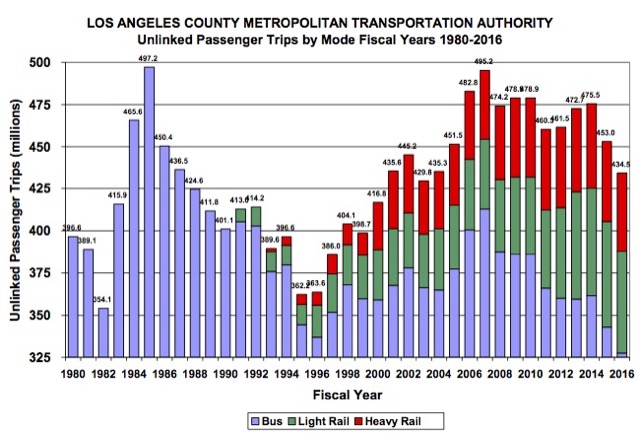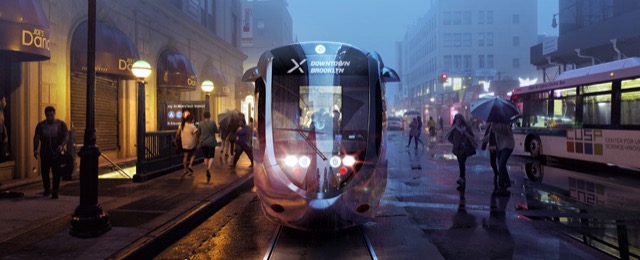The Federal Transit Administration has published its New Starts recommendations for 2017. The recommendations include profiles of more than 60 different transit projects, including bus-rapid transit (BR), streetcars (SR), light rail (LR), commuter rail (CR), and heavy rail (HR). Only 60 projects are shown in the table below as a few, such as the San Antonio streetcar, have been cancelled or at least are “on hold.”
| City | Project | Mode | Miles | Capital | Cost/mi |
|---|---|---|---|---|---|
| Phoenix | S. Central | LR | 5.0 | 531 | 106 |
| Tempe | Streetcar | SR | 3.0 | 183 | 61 |
| LA | Connector | LR | 1.9 | 1,403 | 738 |
| LA | Streetcar | SR | 3.8 | 75 | 20 |
| LA | Purple 1 | HR | 3.9 | 2,822 | 720 |
| LA | Purple 2 | HR | 2.6 | 2,467 | 949 |
| Sac'to | Streetcar | SR | 4.2 | 150 | 36 |
| CalTrans | Electrified | CRC | 51.0 | 1,759 | 34 |
| San Diego | Mid-Coast | LR | 10.9 | 2,171 | 199 |
| San Fran. | Central | LR | 1.7 | 1,578 | 928 |
| San Fran. | Van Ness | BR | 2.0 | 163 | 81 |
| San Jose | El Camino | BR | 17.4 | 188 | 11 |
| San Jose | Berryessa | HR | 10.2 | 2,330 | 230 |
| San Rafael | SMART | CR | 2.1 | 43 | 20 |
| Santa Ana | Streetcar | SR | 4.1 | 289 | 70 |
| Denver | Eagle | CR | 30.2 | 2,043 | 68 |
| Denver | SE Ext | LR | 2.3 | 224 | 97 |
| Ft. Laud. | Wave | SR | 2.8 | 173 | 62 |
| Ft. Laud. | Broward | SR | 5.0 | 0 | |
| J'ville | East | BR | 18.5 | 34 | 2 |
| J'ville | SW | BR | 12.9 | 19 | 1 |
| Orlando | OIA | CR | 5.5 | 225 | 41 |
| Orlando | South | CR | 17.2 | 187 | 11 |
| Orlando | North | CR | 12.2 | 69 | 6 |
| Honolulu | HART | HR | 20.0 | 5,122 | 256 |
| Chicago | Ashland | BR | 5.4 | 117 | 22 |
| Chicago | Red & Purple | HRC | 5.6 | 957 | 171 |
| Indy. | Red | BR | 13.1 | 96 | 7 |
| Boston | Medford | LR | 4.7 | 2,298 | 489 |
| Maryland | Purple | LR | 16.2 | 2,448 | 151 |
| Gr. Rapids | Laker | BR | 13.3 | 71 | 5 |
| Lansing | Michigan | BR | 8.5 | 164 | 19 |
| Minn. | Blue ext | LR | 13.0 | 1 | 0 |
| Minn. | Orange | BR | 17.0 | 151 | 9 |
| Minn. | SW | LR | 14.5 | 1,774 | 122 |
| K. City | Prospect | BR | 10.0 | 54 | 5 |
| Charlotte | Blue ext | LR | 9.3 | 1,160 | 125 |
| Charlotte | Gold | SR | 2.5 | 150 | 60 |
| Charlotte | Blue | HRC | 9.6 | 40 | 4 |
| Durham | Orange | LR | 17.1 | 1,800 | 105 |
| Albuq. | Rapid | BR | 8.8 | 126 | 14 |
| Reno | 4th St | BR | 3.1 | 53 | 17 |
| Reno | Virginia | BR | 1.8 | 60 | 33 |
| Albany | River | BR | 15.0 | 35 | 2 |
| Albany | Washington | BR | 8.0 | 64 | 8 |
| NYC | Carnarsie | HRC | 6.0 | 274 | 46 |
| NYC | Woodhaven | BR | 14.0 | 231 | 17 |
| Columbus | Cleveland | BR | 15.6 | 47 | 3 |
| Portland | Milwaukie | LR | 7.0 | 1,490 | 213 |
| Portland | Powell | BR | 14.0 | 75 | 5 |
| Dallas | CBD | LR | 2.4 | 650 | 271 |
| Dallas | Red & Blue | LRC | 48.1 | 119 | 2 |
| El Paso | Montana | BR | 16.8 | 47 | 3 |
| Ft. Worth | TEXRail | CR | 27.2 | 996 | 37 |
| Houston | University | LR | 11.3 | 1,563 | 138 |
| Provo | BRT | BR | 10.5 | 150 | 14 |
| Everett | Swift | BR | 12.3 | 67 | 5 |
| Seattle | Center | SR | 1.3 | 135 | 104 |
| Spokane | Central | BR | 5.8 | 72 | 12 |
| Tacoma | Link ext | SR | 2.4 | 166 | 69 |
For the projects in this year’s report, the average cost of new streetcar lines is $45 million per mile; light rail is $163 million per mile; heavy rail is $347 million per mile; and commuter rail is $38 million per mile. Of course, cost overruns are likely for a majority of these projects, so the final costs are likely to average 20 to 50 percent more. Even without the overruns, these costs are outlandish, as the nation’s first light-rail lines cost only around $10 million to $25 million per mile (after adjusting for inflation), and streetcars were supposed to be even less expensive than that.









